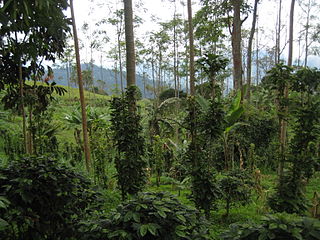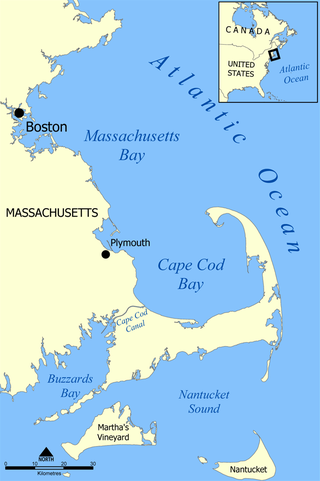Related Research Articles
An autonomous building is a building designed to be operated independently from infrastructural support services such as the electric power grid, gas grid, municipal water systems, sewage treatment systems, storm drains, communication services, and in some cases, public roads. The literature mostly refers to housing, or the autonomous house.
The following outline is provided as an overview of and topical guide to agriculture:

Intensive agriculture, also known as intensive farming, conventional, or industrial agriculture, is a type of agriculture, both of crop plants and of animals, with higher levels of input and output per unit of agricultural land area. It is characterized by a low fallow ratio, higher use of inputs such as capital, labour, agrochemicals and water, and higher crop yields per unit land area.

Fish farming or pisciculture involves commercial breeding of fish, most often for food, in fish tanks or artificial enclosures such as fish ponds. It is a particular type of aquaculture, which is the controlled cultivation and harvesting of aquatic animals such as fish, crustaceans, molluscs and so on, in natural or pseudo-natural environments. A facility that releases juvenile fish into the wild for recreational fishing or to supplement a species' natural numbers is generally referred to as a fish hatchery. Worldwide, the most important fish species produced in fish farming are carp, catfish, salmon and tilapia.

Before contact with Europeans, the Hawaiian people practiced aquaculture through development of fish ponds, the most advanced fish-husbandry among the original peoples of the Pacific. While other cultures in places like Egypt and China also used the practice, Hawaii's aquaculture was very advanced considering the much smaller size of the area of Hawaii compared to other aquacultural societies. Hawaiian fishponds were typically shallow areas of a reef flat surrounded by a low lava rock wall built out from the shore. Several species of edible fish thrive in such ponds, and Hawaiians developed methods to make them easy to catch.

Sustainable agriculture is farming in sustainable ways meeting society's present food and textile needs, without compromising the ability for current or future generations to meet their needs. It can be based on an understanding of ecosystem services. There are many methods to increase the sustainability of agriculture. When developing agriculture within sustainable food systems, it is important to develop flexible business processes and farming practices. Agriculture has an enormous environmental footprint, playing a significant role in causing climate change, water scarcity, water pollution, land degradation, deforestation and other processes; it is simultaneously causing environmental changes and being impacted by these changes. Sustainable agriculture consists of environment friendly methods of farming that allow the production of crops or livestock without causing damage to human or natural systems. It involves preventing adverse effects on soil, water, biodiversity, and surrounding or downstream resources, as well as to those working or living on the farm or in neighboring areas. Elements of sustainable agriculture can include permaculture, agroforestry, mixed farming, multiple cropping, and crop rotation.

Aquaponics is a food production system that couples aquaculture with hydroponics whereby the nutrient-rich aquaculture water is fed to hydroponically grown plants.
John Todd is a Canadian biologist working in the general field of ecological design. He addresses problems of food production and wastewater processing by using ecosystems technologies that incorporate plants, animals and bacteria. Todd has developed "Arks" or "bioshelters", ecologically closed "life-support systems" with the goal of sustainable functioning. He combines alternative technologies for renewable energy, organic farming, aquaculture, hydroponics and architecture to create "living machines" or "eco-machines".

James Tennant Baldwin, often known as Jay Baldwin or J. Baldwin, was an American industrial designer and writer. Baldwin was a student of Buckminster Fuller; Baldwin's work was inspired by Fuller's principles and, in the case of some of Baldwin's published writings, he popularized and interpreted Fuller's ideas and achievements. In his own right, Baldwin was a figure in American designers' efforts to incorporate solar, wind, and other renewable energy sources. In his career, being a fabricator was as important as being a designer. Baldwin was noted as the inventor of the "Pillow Dome", a design that combines Buckminster Fuller's geodesic dome with panels of inflated ETFE plastic panels.

Cape Cod Bay is a large bay of the Atlantic Ocean adjacent to the U.S. state of Massachusetts. Measuring 604 square miles (1,560 km2) below a line drawn from Brant Rock in Marshfield to Race Point in Provincetown, Massachusetts, it is enclosed by Cape Cod to the south and east, and Plymouth County, Massachusetts, to the west. To the north of Cape Cod Bay lie Massachusetts Bay and the Atlantic Ocean. Cape Cod Bay is the southernmost extremity of the Gulf of Maine. Cape Cod Bay is one of the bays adjacent to Massachusetts that give it the name Bay State. The others are Narragansett Bay, Buzzards Bay, and Massachusetts Bay.
Nai or NAI may refer to:
A bioshelter is a solar greenhouse managed as an indoor ecosystem. The word bioshelter was coined by the New Alchemy Institute and solar designers Sean Wellesley-Miller and Day Chahroudi. The term was created to distinguish their work in greenhouse design and management from twentieth century petro-chemical fuelled monoculture greenhouses.
Renewable fuels are fuels produced from renewable resources. Examples include: biofuels, Hydrogen fuel, and fully synthetic fuel produced from ambient carbon dioxide and water. This is in contrast to non-renewable fuels such as natural gas, LPG (propane), petroleum and other fossil fuels and nuclear energy. Renewable fuels can include fuels that are synthesized from renewable energy sources, such as wind and solar. Renewable fuels have gained in popularity due to their sustainability, low contributions to the carbon cycle, and in some cases lower amounts of greenhouse gases. The geo-political ramifications of these fuels are also of interest, particularly to industrialized economies which desire independence from Middle Eastern oil.

Integrated multi-trophic aquaculture (IMTA) is a type of aquaculture where the byproducts, including waste, from one aquatic species are used as inputs for another. Farmers combine fed aquaculture with inorganic extractive and organic extractive aquaculture to create balanced systems for environment remediation (biomitigation), economic stability and social acceptability.
This page is a list of fishing topics.

The fishing industry in the land-locked country of Laos is a major source of sustenance and food security to its people dwelling near rivers, reservoirs and ponds. Apart from wild capture fisheries, which is a major component of fish production, aquaculture and stocking are significant developments in the country. Historically, fishing activity was recorded in writings on the gate and walls of the Wat Xieng Thong in Luang Prabang dated 1560. For many Laotians, freshwater fish are the principal source of protein. The percentage of people involved in regular fishing activity is very small, only near major rivers or reservoirs, as for most of the fishers it is a part-time activity.
Microponics, in agricultural practice, is a symbiotic integration of fish, plants, and micro-livestock within a semi-controlled environment, designed to enhance soil fertility and crop productivity. Coined by Gary Donaldson, an Australian urban farmer, in 2008, the term was used to describe his innovative concept of integrated backyard food production. While "microponics" had been previously used to refer to an obscure grafting method in hydroponics, Donaldson's application of the term was derived from the amalgamation of micro-livestock (micro-farming) and the cultivation of fish and plants, a practice commonly known as aquaponics.
Building-integrated agriculture (BIA) is the practice of locating high-performance hydroponic greenhouse farming systems on and in mixed-use buildings to exploit synergies between the built environment and agriculture.
National Innovations in Climate Resilient Agriculture (NICRA) was launched during February 2011 by the Indian Council of Agricultural Research (ICAR) with the funding from the Ministry of Agriculture, Government of India. The mega project has three major objectives of strategic research, technology demonstrations and capacity building. Assessment of the impact of climate change simultaneous with formulation of adaptive strategies is the prime approach under strategic research across all sectors of agriculture, dairying and fisheries.
The Ark was a bioshelter constructed in Spry Point, Prince Edward Island, designed by architects David Bergmark and Ole Hammarlund, who relocated from the USA to design the project under their firm's name Solsearch Architects. The other major contributor was a New England ecological research center, called The New Alchemy Institute, which conceptualized the PEI Ark. The goal of the New Alchemy institute was to study non-violent and non-lethal methods to secure the future of humanity as stated by one of the project's participants.
References
- 1 2 Gordon, Alastair (April 12, 2018). "Remembering Jay Baldwin, experimental geodesic dome champion - Archpaper.com". archpaper.com. Retrieved May 18, 2018.
- 1 2 3 4 5 6 7 8 9 10 Rose, Steve (September 29, 2019). "The New Alchemists: could the past hold the key to sustainable living?". The Guardian . Retrieved January 25, 2025.
- ↑ Hugus, Elise (December 16, 2014). "The Cape Cod Ark". Edible Cape Cod. Retrieved January 25, 2025.
- 1 2 3 "About". The Green Center. January 26, 2015. Retrieved January 25, 2025.
The Green Center is a non-profit educational institute that evolved from The New Alchemy Institute. With the help of a small board of directors and volunteers, former New Alchemists Hilda Maingay and Earle Barnhart continue NAI's mission...
- ↑ Fall 1970, Bulletin of the New Alchemists.
- ↑ "Home". The Green Center. September 7, 2020. Retrieved January 25, 2025.